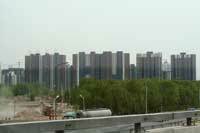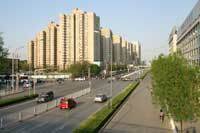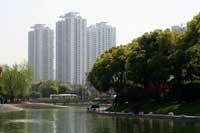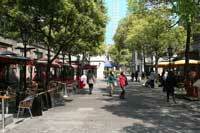Landscape PLANNING: Definitions Planning Agriculture Context theory Cycling EID Forestry Green Towns Greenways Landscape plans Minerals Parks POS Reservoirs Rivers Sustainability Transport Urbanisation Books on landscape planning Links
See also Context Theory and Tiananmen Square Landscape Competition
Qiu Baoxing, the Chinese Vice-minister for Construction, criticised his country's lack of a contextual design policy. He is right. China's urban design policy has always been standardised but there is no reason why this should remain the case. Travelling round China in the early twentyfirst century makes one wonder if a party of Chinese officials were driven up the New Jersey Turnpike, after the 1972 Nixon-Mao summit perhaps, and concluded 'this is a very paradise - let us go home and build 80,000 km of turnpike highway and use it to connect 500 Chicagos with 500 Los Angeles, to the greater glory of the People's Republic'. The UK has approximately 5,000 landscape architects for a population of 50m. To achieve the same ratio, with a population 24 times the size of UK, China needs 120,000 landscape architects, probably in the ratio of 50:50 for landscape planners to landscape designers. If the art of garden design is to revive in China, the country probably needs at least as many garden designers.
Jonathan Watts reported (on Tuesday June 12, 2007 in The Guardian) "China has become the land of 1,000 identical cities, a senior government official has warned in an outspoken attack on the country's rush towards modernity. Qiu Baoxing, the vice-minister of construction, said the damage to the country's heritage was similar to that wrought during the cultural revolution of 1966-76. In the early stages of that period, Red Guards ransacked temples and burned ancient scripts in the name of revolutionary politics. Today, the damage is more likely to be done by urban developers in the name of economic progress. Historical sites and cultural relics have been devastated by "renovation" projects, Mr Qiu was quoted as saying by the China Daily. In an unusually fierce criticism of the architectural landscape of modern China, the vice-minister said that too many local governments were guilty of a "blind pursuit of the large, the new and the exotic"."This is leading to a poor sight," he said. "Many cities have a similar construction style. It is like a thousand cities having the same appearance." He said such "senseless actions" were the fault of local officials, who were "totally unaware of the value of cultural heritage".His comments underscore concerns that China, one of the world's oldest civilisations, is paying too high a price for its economic expansion.Throughout the country, old buildings are making way for residential towers, office blocks and motorways. Developers have torn down tens of thousands of traditional courtyard homes in Beijing, countless colonial-era neighbourhoods in Shanghai and swaths of other historical cities. In their place are wide streets, concrete squares and huge right-angled buildings - often with the same small white tiles and blue-tinted windows.In Lhasa, such is the threat to traditional Tibetan architecture that the World Heritage Committee called on China to reconsider its demolition plans a few years ago.Even many so-called heritage schemes have a dubious value. The Xintiandi area of Shanghai was flattened and rebuilt in an old style - plus a Starbucks cafe, bars and boutiques. Such is its commercial success that many other municipalities consider it a model for "cultural renovation".Tong Mingkang, deputy director of the state administration of cultural heritage, said this faking of history made the country poorer. "It is like tearing up an invaluable painting and replacing it with a cheap print," he told the state media"

Beijing 'urban landscape design'

Street landscape in Beijing

Surburban 'landscape design' outside Shanghai

Shanghai urban park, designed by an American firm of landscape architects (SOM)

Xintiandi is a re-creation of a recently demolished urban landscape 'plus a Starbucks cafe'